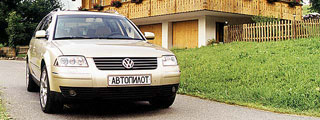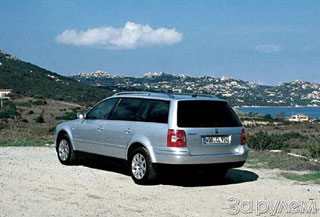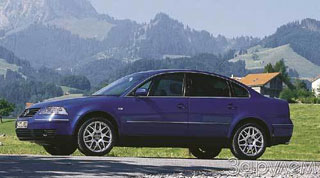Test drive Volkswagen Passat B5 2000 - 2005 sedan
In the traditions of the brand
 The new Passat as a MARDER combat vehicle, which I drove when I pulled an urgent in the 312th battalion of the 11th Panzer-Grenadier Division of Bundeswehr, in Oldenburg. I remember that the chief feldfebel Limka liked to repeat, instructing us, young driver mechanics: Marder is controlled and obedient, like a wife, until you get her crazy.
The new Passat as a MARDER combat vehicle, which I drove when I pulled an urgent in the 312th battalion of the 11th Panzer-Grenadier Division of Bundeswehr, in Oldenburg. I remember that the chief feldfebel Limka liked to repeat, instructing us, young driver mechanics: Marder is controlled and obedient, like a wife, until you get her crazy. In the new Passat you sit down and, Naturlich, everything inside is close and familiar: the upholstery, the stiffness of the seat, and the switches. And the devices shine with otherworldly pale purple, only the chrome rims have been added. Pts, it shades the gray-black color scheme of the salon! In general, the full Ordnung und Disziplin, old-Passat inside is at a height. The ocher is especially impressed on the ceiling to the left of the driver's seat (there used to be a pen), the same as in a new beetle. Now there is no need to drag the sunglasses with yourself or every time to remember in which of the pockets of the salon left them.
Of the new products, it is worth noting the console between the front seats. It is more spacious than before, and the soft upper surface serves as a convenient support for the elbow of the right hand. But ... In the previous version, the box between the seats could be thrown back and active drivers acted so as not to cling to it with the elbow during switching. Now the console is motionless and, as it turned out later, slightly interferes when the second and fourth gears are turned on.
If we turn to the internal size of the car, the company, it turns out that six millimeters of air were added above the driver’s head, four above the rear sofa. The trunk became more. Such a millimeter is evidence of the highest skill of components!
At first glance, there were no changes in the mechanical filling of Passat, the same platform B5. But Volkswagen claims that in the car there are already 2315 new parts, they are simply not visible from the outside! First of all, those elements of the body that are responsible for its stiffness are converted.
External changes are more noticeable. Lining the front of the updated Passat is tilt, like the upper front of the Marder. A massive barred slab is given forward, a sure sign of once again changed fashion. The predecessor, as it were, brought the line under the last one and a half decades of the era of bio -design. And although in Volkswagen cars, biological motifs were present to a lesser extent than in models of other manufacturers, it did not completely do without them ...
New wings, bumpers, hood and trunk cover from the previous car remained only a roof and doors. Chrome appeared in the body decoration. New lighting technology: in front of the headlights with a free surface, behind the lanterns with unusual linz circuits. The wheelbase has not changed, the track has become more wider than 17 mm. The front is elongated by 15 mm, and the rear overhang is 13 mm, which emphasizes the grown class of the machine ...
If you now put a tin-Passat of the first generation (1973) nearby, the scale of advancement will be even more obvious. But twenty -seven years ago, a newly born car, named after one of the most friendly ocean air currents, seemed embodied by the dream of a burgher! And my dad, a sewage specialist, as soon as the opportunity introduced himself, acquired such Limousine-Funfturer with a hefty rear hatch (yes, yes, the first two generations Passat had options for hatchback, only in German terminology there are no such designation to this day).
The first notes about the new car appeared in newspapers at the end of July 73, and since then there was no question in our family. The old Opel-Rekord was given to me to be torn to pieces (my father said: study the device, grow up, they will value the army). In the spring of the 75th, his father proudly rolled into the courtyard on a brand new car ...
A couple of years after the purchase through the rubber seals of the hatch, dust and moisture began to penetrate into the salon; When driving along a cobblestone bridge, Luke moaned and creaked like a construction winch. Then the Rhine spilled (floods in our area are familiar), and Passat stood on the thresholds in the water for three days. Having received insurance, Mein Lieber Vater did not wait until the body blooms and sold the car ...
Then we also bought Volkswagen, only less jetta. The end of the seventies was not the most successful time. Gasoline was standing. For a liter of normal in 1980, 1.13 brands were asked, in a year only 1.8 stamps think. But at Christmas, I remember, my father started a conversation about buying Passat every time.
Finally, we were able to master this in 1981, when the entire venerable family of Wessels moved from Bislisha to Fulda, where the paternal company received a profitable contract.
In November 1980, the second generation of the car debuted. Therefore, when a car exhibition took place in Frankfurt in September 1981, we went there the whole family. A hit on the Volkswagen stand was Passat Santana ... with a step back.
The cars of the new family were now no longer similar to Audi. (And right: the differences in the equipment are not visible to everyone, but how much there are one or four in the cladding of circles, the difference is small.) Here we have already seen a car with a spacious body designed for a large family, a dog and all that. Audi (if this is not a universal-avant) car for an individual or a small family. By the way, in the mechanic, the owner of Passat did not lose to the owner of the Audi 80 motors (even a 54-horsepower diesel!) Were the same. Now I don’t remember, it seems, the door handles from one car approached another.
(By the way, the Passat of the 2001 model year with complete external unlike Audi retains the unification traditional for the brand. With the advent of ex-chanth Audi Ferdinand Piekh, this unification was aggravated and at the same time became less noticeable to the uninitiated gaze. The secret of the Madrid court.)
Father hesitated to take a station wagon with a trunk up to 1800 liters or Santana. The latter defeated the latter, he had a 1.9 liter of a 5-cylinder engine, in the best traditions of which today's, one of the most powerful engines in the Passat 2.3 l VR5 gamut with close rows of cylinders.
Wherever Santana was released! In the Brussels branch, in Brazil at the ANTITA factory called Santana (sedan) and Quantum (station wagon). It began with a Shanghai plant, where the first cars from Brussels were assembled in 1983. Chinese cars were called Santana and Santana Variant.
The representative of the second generation of the Passats was destined to make a journey to Russia with his father (not such a dramatic one, as it fell to the share of his grandfather). The father’s company received a contract for construction work in the most prestigious hotel in Russian metropolis.
In Oldenburg, I had to drive not only the infantry combat vehicle, but also the protective color of the first -generation Olivegrun Passat, assigned to the brigade commander. It was then that I appreciated this understanding, very high-quality in interior decoration (Opel and did not stand close). The controllability was one of the trousers of Passat, because he replaced the rear -engine VW 1600 on the conveyor in Emden with the inherent machines of such a layout sensitivity to the side wind and uncertain turns. Passat wrote turns with a bang ...
A year and a half military service flew rapidly. Waiting for dismissal, I looked after myself a new car. The magazines leafed through: Volkswagen showed experimental Forschungsauto one by one, reduced the aerodynamic resistance and fuel consumption ... the third-generation Passat, which appeared in April 1988, looked exactly like one of the glurated prototypes. What I liked with him was the impressive box of the trunk. (Pay attention to the small innovation of 2001, the trunk threshold is lined with an aluminum plate. Not only a stylish thing, but also useful you can’t wrap it with a heavy suitcase.)
Having risked, I acquired the most cool version, G60 Syncro just by September of the 89th I got some money. The highlight of the car was a small part, G-Lader, a spiral mechanical supercharger that raised the power of a base of 1.8 liters of four to 160 hp! They asked for a car with a highlight a lot of 46.240 brands. You were lucky, guy, they convinced me, the weeks will not pass, and there will be a queue for this thing. So it happened, but then I was occupied by the opportunity to surprise my father, with whom I started just some kind of competition.
By that time, he managed to change the horse. Knowing his passion for Passat, his friends slipped his article about the third-generation universal-Variant, who, instead of the springs of the rear suspension, stood the Monroe pneumatic resistance. The body no longer sagged under the weight of the luggage system itself chose a slack. In the trunk on the left, under the skin there was a WABCO compressor, which increases pressure in the pneumressors. But alas, this was just another experiment that did not reach dealers.
The father chose the Passat Variant Syncro, an all-wheel drive, with a 4-speed automatic and electronic locking of the front wheel differential, which automatically disconnected at a speed of more than 40 km/h, it was required only to drive the mud.
I represented my father’s facial expression when the boom in the house on the bright red G60 with wide matte-black moldings almost Ferrari! But it turned out that he surprised me, telling me that the car cost him almost 1200 marks cheaper, he purchased it from Euromobils, one of the Grau-Importeureren. So not only in Russia there is a gray import ...
My G60 today is in the garage of a collection copy! It is a pity, now the model range is not replete with such an exclusive. But you can understand the company: it is necessary that both Audi be enough for bread with butter and tuning workshop, which finally turned their eyes to the old days-Passat. So, it’s a pity, and the accents in the production program are placed correctly. The most popular product is a machine with a 1.8 liter gas with a capacity of 150 hp. With turbocharged.
And, of course, I share the decision of Volkswagen to return to the place of the radiator grille. I do not argue, in that model there was something from the future. The third Passat car without a radiator cladding, air entered it through the cracks in the bumper and a hole covered with a large emblem. But the emblem soon fell off (or it was torn off), and there was an ugly hole. For me, it is better to have a hole in jeans than in the car, but understand this tiny part cost fifty marks at the dealer! Well, in general, I looked at the front end with a different look and did not grieve when in 1993 Volkswagen made facilifting in favor of a more traditional, lattice front. In the company, this car is called the fourth generation of Passat, only I strongly disagree with this: two standard airbags, ABS, front belts, rear seats and electronic immobilizers, all the changes, the ABS pillows. And the facing of the front line, of course ...
So what is the new Passat in comparison with the predecessor? In behavior, almost unchanged, but slightly more tightened (perhaps the increased body rigidity of the body has positively affects). Otherwise, all the same Passat, with its hard comfortable seats, informative governing bodies, slightly stretched gear, expressed insufficient rotation, excellent sound insulation ... with a reputation as one of the most stolen cars in Moscow, finally.
But the image is a significant step forward. At first glance, restyling seems radical, but it is worth walking around the car, and each time she likes it more and more. And the rear lights no longer seem so revolutionary, and the abundance of chromium in the decoration looks quite natural. It is even amazing how the company managed to change not only the appearance, but also the status of a car ...
P. S. In 2001, Volkswagen is going to sell 444,000 new Passat, of which about 100,000 in the USA.
Hans Wessel
Video Test Drive Volkswagen Passat B5 2000 - 2005
VOLKSWAGEN Passat B5 2000 - 2005 - 2005
Volkswagen Passat B5 2000 test drives - 2005
Krash Test Volkswagen Passat B5 2000 - 2005
Krassh Test: Detailed Information28%
Driver and passengers
13%
Pedestrians
Malfunctions Volkswagen Passat B5 2000 - 2005
Volkswagen Passat malfunctions: Detailed information| Passat B5 2000 - 2005 | |
|---|---|
| Engine |  |
| Transmission |  |
| Control system and suspension |  |
| Brake system |  |
| Air heating and air conditioning |  |
| Launch and charging system |  |
| Electric components and so on |  |
| Corrosion body stability |  |












